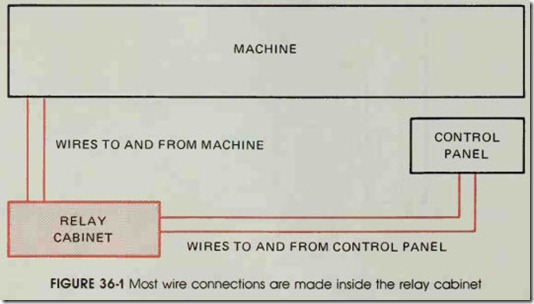Objectives
After studying this unit, the student will be able to:
• Discuss the installation of control circuits
• Use the number system on a schematic diagram to troubleshoot a circuit
Wiring diagrams can be misleading in that they show all components grouped togeJher. In ac tual practice, the control relays and motor starters may be located in one cabinet, the push buttons and pilot lights in a control panel, and pilot de vices, such as limit switches, and pressure switches, may be located on the machine itself, figure 36-1. Most control systems use a relay cab inet to house the control relays and motor starters. Wiring is brought to the relay cabinet from the push buttons and pilot lights located in the control panel, and from the pilot devices located on the machine. All of the connections are made inside the relay cabinet.
Relay cabinets generally contain rows of terminal strips. These terminal strips are used as connection points between the control wiring in side the cabinet and inputs or outputs to the ma chine or control panel. Most terminal strips are designed so that connection points can be numbered. This type of system can be more costly to install, but it will more than pay for the extra cost in the time saved when troubleshooting. For ex ample, assume that an electrician desires to check limit switch LS15 to see if its contacts are open or closed. Limit switch LS15 is located on the ma chine, but assume that in the schematic one side of the limit switch is number 25 and the other side of the limit switch is number 26. If numbers 25 and 26 can be located on the terminal strip, the electrician can check the limit switch from the re lay cabinet without having to go to the machine and remove the cover from the limit switch. The electrician will only have to connect the probes of his voltmeter across terminals 25 and 26. If the voltmeter indicates the control voltage of the cir cuit, the limit switch contacts are open. If the voltmeter indicates 0 volts, the limit switch con tacts are closed.
REVIEW QUESTIONS
1. Define a wiring diagram.
2. Are symbols in a schematic shown in their energized or de-energized condition?
3. Draw the standard NEMA symbol for the following components.
A. Float switch (NO)
B. Limit switch (NC)
C. Normally open push button
D. Relay coil
E. Overload contact
